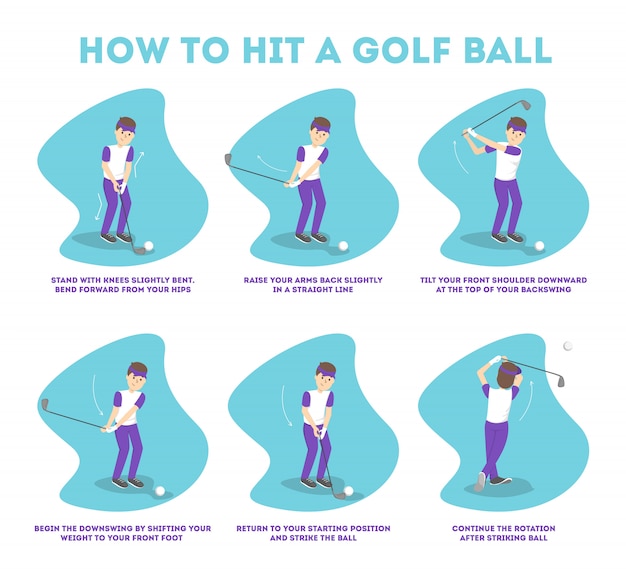
Golf Rules for Beginners: A Comprehensive Guide to Getting Started
Golf, a game of precision and strategy played on a sprawling course, can seem intimidating to newcomers. The sheer number of rules can be overwhelming, but understanding the basics is crucial for enjoying the game and respecting fellow players. This comprehensive guide simplifies the essential rules for beginners, providing a solid foundation for a positive and enjoyable golfing experience.
I. The Course and Equipment:
Before diving into the specifics of gameplay, let’s understand the layout and equipment. A golf course consists of 18 holes, each with a teeing ground (where you start), a fairway (the closely mown area between the tee and the green), rough (longer, less manicured grass), hazards (water, bunkers – sand traps), and the green (the meticulously manicured area surrounding the hole).
Your equipment typically includes clubs of varying lengths and designs, each suited for different shots: drivers (for long distance off the tee), irons (for approach shots), wedges (for short shots around the green), and a putter (for sinking the ball into the hole). Golf balls are small, usually white, and designed for optimal flight and spin.
II. Basic Gameplay and Etiquette:
The objective is simple: get the ball into the hole in the fewest possible strokes. Each stroke counts towards your score for that hole. The total score across all 18 holes determines your round score.
Etiquette is paramount:
- Repairing divots: After hitting a shot from the fairway, repair the divot (the chunk of turf removed by your club) to maintain the course’s condition.
- Raking bunkers: Always rake the sand in bunkers after your shot, smoothing the surface for subsequent players.
- Replacing divots on greens: If you accidentally displace turf on the green (a pitch mark), repair it with a repair tool.
- Keeping pace of play: Be mindful of the players behind you and maintain a reasonable pace. Avoid unnecessary delays.
- Quiet during other players’ swings: Silence is crucial when someone is about to hit their shot. Distractions can affect their performance.
III. Key Rules for Beginners:
While the full rulebook is extensive, understanding these core rules will help you navigate the course confidently:
-
Out of Bounds (OB): Areas marked by stakes or lines are out of bounds. If your ball lands out of bounds, you incur a penalty stroke and must play another ball from where your previous stroke originated.
-
Lost Ball: If you cannot locate your ball within five minutes of searching, it’s considered lost. You incur a penalty stroke and must play a new ball from where your previous stroke originated.
-
Water Hazards: Water hazards are clearly marked. If your ball lands in a water hazard, you have several options:
- Play the ball as it lies: Attempt to hit the ball from its location.
- Take a penalty stroke and drop: Drop a ball within one club-length of where your previous shot entered the hazard, no nearer the hole. This is often referred to as a "penalty drop."
- Take a penalty stroke and drop: Drop a ball two club-lengths behind the point where your previous shot crossed the margin of the hazard.
-
Bunker (Sand Trap) Play: You cannot ground your club in a bunker before hitting the ball. This means you must hit the ball from the sand without allowing your club to touch the ground. If you do, it’s a one-stroke penalty.
-
Stroke Play: This is the most common scoring system. Each stroke you take counts towards your score for the hole. The player with the lowest total score after 18 holes wins.
-
Match Play: In match play, you compete hole by hole against your opponent. The player who wins the most holes wins the match. The overall score for the round is irrelevant.
IV. Understanding Penalties:
Penalties are crucial in golf. They are usually one stroke, but the severity can depend on the infraction. Common penalties include:
- Improper dropping: If you don’t follow the correct procedures for dropping a ball (e.g., dropping it from knee height), you incur a penalty.
- Touching the ball on the green before putting: This results in a one-stroke penalty.
- Moving the ball during play: Accidental or intentional movement of your ball results in a penalty.
- Playing the wrong ball: Using a ball that is not yours will lead to disqualification.
V. Tips for Beginners:
- Start with lessons: Professional instruction is invaluable. A qualified golf instructor can teach you proper grip, stance, and swing techniques.
- Practice regularly: Consistent practice is key to improving your game. Focus on specific aspects of your swing and short game.
- Play with experienced golfers: Learn from more experienced players by observing their etiquette and techniques.
- Don’t get discouraged: Golf is challenging. It takes time and patience to master the game. Focus on improvement rather than perfection.
- Have fun! Golf is a social and enjoyable sport. Remember to relax, enjoy the scenery, and appreciate the camaraderie with your fellow players.
VI. Resources for Further Learning:
This guide provides a foundational understanding of golf rules for beginners. For a more detailed understanding, consult the official Rules of Golf published by The R&A and the USGA. These rulebooks are available online and in print. Many online resources and videos also offer tutorials and explanations of golf rules and etiquette.
Mastering the rules of golf takes time and dedication, but the rewards are significant. By understanding the basics and practicing regularly, you’ll not only improve your game but also enhance your enjoyment of this classic and challenging sport. Remember that respect for the course, fellow players, and the rules is crucial for a positive and memorable golfing experience. So grab your clubs, head to the course, and enjoy the game!



